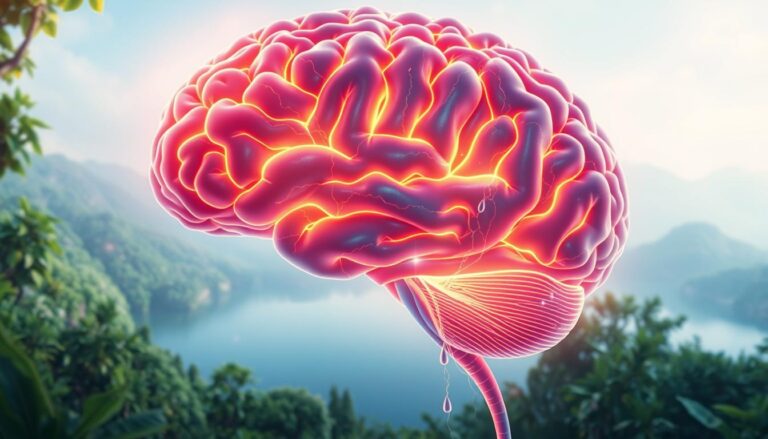Did you ever think that eating fat rich foods could protect your heart? Nutrition science has changed showing that some fats are good for us.
The American Heart Association now says to replace bad fats with good ones.
Studies show that eating less saturated fat and more unsaturated fat can lower heart disease risk by 23%. This change is backed by 60 clinical trials. They found that healthy fats can lower bad cholesterol and raise good cholesterol.
Fats are important for our cells, hormones, and how we absorb nutrients. The OmniHeart study showed that unsaturated fats can lower blood pressure and heart disease risk. Even small changes like using olive oil instead of butter, can help.
It’s recommended to get 8-10% of our daily calories from polyunsaturated fats. Knowing which fats are best is key to staying healthy.
Key Takeaways
- Replacing saturated fats with unsaturated options lowers heart disease risk by reducing LDL cholesterol.
- Healthy fats like those in avocados and fatty fish improve blood pressure and insulin sensitivity.
- American Heart Association guidelines advise keeping saturated fats below 7% of daily calories.
- Diets rich in omega-3s from fish and nuts support brain function and reduce inflammation.
- Unsaturated fats enhance nutrient absorption of vitamins A, D, E, and K.
Understanding Dietary Fats Beyond the Misconceptions
Dietary fats were once seen as harmful for decades. Now, research shows they play a more complex role. There are different types of fats: saturated, trans monounsaturated, and polyunsaturated. Early advice to eat very little fat ignored their benefits, like storing energy and helping vitamins.
The Evolution of Fat Perception in Nutrition Science
Nutrition science has moved from fearing all fats to understanding their variety. Studies once linked all fats to heart disease. But now we know saturated and trans fats are only harmful in excess. Experts say to replace them with unsaturated fats to lower bad cholesterol.
Debunking Common Myths About Dietary Fats
- Myth: All fats cause weight gain. Fact: It’s excess calories, not fats, that lead to weight gain. Unsaturated fats help with feeling full and staying healthy.
- Myth: Fat free foods are healthier. Fact: Many low-fat products have added sugars, which are bad for the heart.
- Myth: Coconut oil is universally healthy. Fact: Its high saturated fat content 86% means it should be eaten in moderation.
The Difference Between Natural and Artificial Fats
Natural fats, like those in salmon and almonds, are full of good fats. Artificial trans fats, found in fried foods and baked goods, increase heart disease risk. The World Health Organization wants to ban all industrially made trans fats.
Health experts say to swap saturated fats (like butter) for unsaturated ones (like olive oil). This helps keep cholesterol levels right and supports cells. Eating whole foods ensures you get the health benefits of fats in nutrition without the risks.
Types of Healthy Fats Your Body Needs
Knowing the different types of fats is key to getting the most from them. Each type helps in various ways, like keeping your heart healthy and boosting energy.

Monounsaturated Fats: Heart Healthy Options
Monounsaturated fats are good for your heart. They help lower bad cholesterol and increase good cholesterol. You can find them in:
- Olive oil and avocado
- Almonds, peanuts, and pistachioss
- Pepperoni and pumpkin seeds
Polyunsaturated Fats Essential Fatty Acids
These fats are vital because our bodies can’t make them. They include:
- Omega-3s: Found in salmon, flaxseeds, and walnuts, they reduce inflammation and support brain health.
- Omega-6s: Present in sunflower oil and pine nuts, they aid in skin and hair health but require balance with omega-3 intake.
Medium Chain Triglycerides MCTs Quick Energy Sources
MCTs are quickly turned into energy. They come from coconut oil and MCT oil. They help with weight management and brain function.
Omega-3 and Omega-6 Fatty Acids: Finding the Right Balance
The best ratio of omega-6 to omega-3 is 4:1. But most diets have too much omega-6. The American Heart Association suggests eating fatty fish like salmon or mackerel twice a week to increase omega-3s.
| Type | Sources | Key Benefits |
|---|---|---|
| Monounsaturated | Olive oil, avocados | Reduces heart disease risk |
| Polyunsaturated | Salmon, walnuts | Essential for brain and cell function |
| MCTs | Coconut oil | Quick energy, supports metabolism |
Getting the right amount of these fats is important for heart health and energy. They are key to a balanced diet and meeting health goals.
What is the Benefit of Including Fat Rich Foods in Our Meals?
Adding benefits of adding fats to diet to our meals is key for our health. Fats give us 9 calories per gram, making them a great energy source. They help our bodies absorb vitamins A, D, E, and K. This is important for our cells and hormones.
Fat-rich foods benefits also help our hearts. Omega-3 fatty acids in these foods lower inflammation and improve our blood fats.
- Energy Efficiency: Fats give us more energy than carbs or proteins.
- Vitamin Absorption: They help us absorb vitamins important for our immune system and eyes.
- Cardiovascular Support: They lower bad cholesterol and raise good cholesterol when we choose unsaturated fats.
- Cellular Health: They are vital for our cell membranes and nervous system.
Diets rich in unsaturated fats lower heart disease risk by improving arterial health. – American Heart Association
It’s important to eat fats in the right amounts. The UK says men should have no more than 30g of saturated fats a day. Women should not have more than 20g. We should also limit trans fats to less than 5g.
Eating fatty fish like salmon twice a week is good for our brains and hearts. Fat-rich foods benefits also help us feel full longer. This can stop us from eating too much. Foods like avocados, nuts, and olive oil are good choices because they are full of nutrients but not too many calories.
Remember, everyone’s needs are different. Always listen to your body and follow the recommended fat intake for your health.
The Role of Fats in Brain Function and Development

The human brain is made up of fats, with 60% of its dry weight being lipids. Docosahexaenoic acid DHA an omega-3 fatty acid, makes up 30% of the brain’s gray matter. This shows how important fats are for brain health and function.
Getting the right fats helps with neural signaling, memory, and mental clarity. It’s key for our brain to work well.
How Dietary Fats Support Cognitive Performance
Omega-3 fatty acids help with brain connections and how neurotransmitters work. A study in Annals of Neurology 2012 showed that more omega-3s mean a bigger brain. This could help slow down brain aging.
But, eating too much saturated fat can double the risk of Alzheimer’s in older people. It’s important to keep the omega-6 to omega-3 ratio right to avoid brain inflammation.
Essential Fats for Children’s Developing Brains
DHA is key for brain development in kids. It helps with myelination and neuron growth. Pregnant women need to eat foods rich in omega-3s for their baby’s brain.
The PREDIMED trial showed that eating Mediterranean foods can help keep the brain young. Foods like nuts, fish, and olive oil are good for brain health. Kids who don’t get enough of these fats might develop slower.
Fats and Mood Regulation: The Gut-Brain Connection
Short-chain fatty acids SCFAs from fermented foods or prebiotic fibers like GOS change the gut microbiota. These changes help reduce inflammation and improve mood. A
2014 study
found that an unhealthy gut is linked to autism and depression. Omega-3s also help lower stress hormones, protecting the brain.
Energy and Satiety How Fats Keep You Fuller Longer
Healthy fats are key for keeping energy up and hunger down. They have 9 calories per gram, which is more than carbs or protein. This makes them important for slowing digestion and keeping you full longer.
When you eat fats, they send signals to your brain that you’re full. They also stop the hunger hormone from working too much. This helps you feel satisfied for longer.
Medium chain triglycerides MCTs in foods like coconut oil enhance satiety more effectively than long chain fats noted St-Onge et al. 2003. A study showed MCT rich breakfasts reduced lunch intake by 220 kcal compared to long-chain alternatives.
Different fats have different effects. Polyunsaturated fats, found in fish oil, make you feel fuller than saturated fats. For example, MCTs are broken down quickly, which helps burn more energy and eat less later.
On the other hand, eating too much saturated fat can make you hungrier. This is because it increases certain chemicals in your body that signal hunger.
- MCTs in coconut oil or avocado trigger faster metabolism, aiding weight management.
- Omega-3 fatty acids in salmon boost CCK release, making you feel full.
- High-fat meals with balanced fiber e.g. nuts optimize satiety without excess calories.
Adding fats like avocado to salads or using olive oil in cooking is smart. It’s all about choosing unsaturated fats and watching how much you eat. This keeps your energy up and helps you stay balanced in the long run.
Fat Soluble Vitamins Maximizing Nutrient Absorption
Healthy fats are key for getting the most out of vitamins A, D, E, and K. These vitamins need fats to be absorbed into the blood. Without enough fat, even foods rich in these vitamins can’t reach our bodies.
Vitamin A is important for our eyes and immune system. It needs fats to work right. Adults should get 700–900 mcg RAE daily, but many don’t get enough.
Adding olive oil to spinach salads can increase carotenoid uptake by 7 times. This is because fats help our bodies use these nutrients better.
Vitamin D works best when eaten with fatty foods. For example, cod liver oil with salmon boosts its absorption. Adults need 600–800 IU daily, but many diets lack enough fat for this.
Low-fat diets can lead to vitamin D deficiency. This is linked to conditions like osteomalacia. So, it’s important to eat foods with healthy fats.
Vitamins E and K also need fats to be absorbed. Eating nuts with avocado or leafy greens with olive oil helps. Studies show that without fats, vitamin E absorption drops by 50%.
Adding avocado to salads or cooking tomatoes with olive oil can help. Even full-fat dairy with fortified cereals is beneficial. These simple steps make sure our bodies get all the nutrients they need.
By focusing on healthy fats, we ensure our cells get the vitamins they need. This is essential for our bodies to work well.
Inflammation Management Through Strategic Fat Consumption
Chronic inflammation can lead to serious diseases like heart disease and diabetes. Choosing fats wisely can help lower these risks. The benefits of adding fats to diet include better control over inflammation, thanks to anti-inflammatory fats.
Omega-3 fatty acids, found in fish, help reduce inflammation. They lower harmful markers like CRP and IL-6. Studies show that fish oil supplements can do this in people with high blood pressure.
On the other hand, too much omega-6 from processed foods can increase inflammation. It’s important to balance omega-6 and omega-3 fats to manage inflammation well.
- Omega-3-rich foods salmon, walnuts inhibit inflammatory eicosanoids.
- Olive oil’s oleocanthal mimics anti-inflammatory drug effects.
- High omega-6 diets fried foods elevate CRP levels by 15–30%.
Research shows simple ways to fight inflammation. Replacing trans fats with monounsaturated fats can lower CRP by 22%. A 2020 study found that Alzheimer’s patients on ketogenic diets saw less cognitive decline and inflammation.
Plant-based proteins are also linked to lower IL-6 levels compared to animal proteins.
To benefit from fat-rich foods benefits, eat fatty fish twice a week, use olive oil, and cut down on processed snacks. These choices follow the Dietary Inflammation Index, reducing the risk of chronic diseases. Even small changes in fat choices can lead to big improvements in health markers like CRP and TNF-α.
Top Fat Rich Foods to Add to Your Diet
Adding fat-rich foods to your diet can boost your heart health and help your body absorb nutrients better. Here are some top picks to make your meals more nutritious:

Plant-Based Sources of Healthy Fats
- Walnuts, flaxseeds, and chia seeds are packed with omega-3s and fiber. Chia seeds give you 5g of omega-3 ALA per tablespoon.
- Avocados are full of monounsaturated fats. Half an avocado has 10g of healthy fats and 160 calories.
- Olives and olive oil are rich in antioxidants and vitamin E. Choose extra-virgin olive oil for the best nutrients.
Animal Based Sources of Quality Fats
Fatty fish like salmon, mackerel, and sardines are great for omega-3s. The American Heart Association suggests eating them twice a week. Eggs are also good, providing cholesterol-neutral fats and vitamin D. Choose pasture-raised eggs for more omega-3s.
| Food | Omega-3 Content g per 100g |
|---|---|
| Salmon | 2 |
| Sardines | 1.6 |
Oils and Cooking Fats: Making the Best Choices
Choose oils based on their smoke points. The chart below helps match cooking methods with the right oil:
| Oil | Smoke Point °F | Use |
|---|---|---|
| Avocado Oil | 520 | High heat frying |
| Extra Virgin Olive Oil | 375 | Sauces, dressings |
| Coconut Oil | 350 | Low heat cooking |
Try to limit saturated fats, like those in red meats and butter, to less than 10% of your daily calories. Choose oils with a better omega-6/omega-3 ratio like flaxseed or canola oil.
Adding these foods to your diet can greatly benefit your health. Focus on whole foods and control your portions for the best results.
How to Incorporate Healthy Fats into Different Meal Types
To add health benefits of fats in nutrition to your day, plan ahead. This guide shows how to add fat-rich foods to meals. They give lasting energy, help absorb nutrients, and boost health.
Breakfast Ideas Featuring Beneficial Fats
- Add 1 tbsp chia seeds to oatmeal for 2.95g polyunsaturated fats and 1.91g fiber per serving.
- Top whole-grain toast with avocado slices 14.7g fat per 100g or 1 oz walnuts (18.5g fat) for crunch.
- Incorporate 2 tbsp almond butter 14g fat into smoothies or yogurt parfaits.
Lunch and Dinner Integration Strategies
Choose olive oil-based dressings 14g fat/tbsp and roast salmon 11.8g fat/3 oz twice a week. Tofu 4.19g fat/100g is great in stir-fries. Add flaxseeds or olives 10.9g monounsaturated fat/100g to salads for texture.
Snacks and Desserts Satisfying Options
- Pair apple slices with 1 oz almonds 14.1g fat or 1 oz dark chocolate 12.1g fat, 70-85% cocoa.
- Mix 1 tbsp ground flaxseed into yogurt or cottage cheese for omega-3s.
- Try homemade energy balls combining dates, nuts, and coconut oil 12.1g sat fat/tbsp.
Follow USDA guidelines to keep saturated fats under 10% of daily calories. Use olive oil instead of margarine to avoid trans fats. Choose whole foods over processed ones for the best health benefits of fats in nutrition.
Finding Your Optimal Fat Intake: Personalization Factors
Adjusting fat intake needs a look at your unique biology and lifestyle. The importance of dietary fats changes with age, how active you are, and your health goals. For instance, people who are very active might need more fat for energy. Those with heart issues might focus on unsaturated fats.

Even genetically identical individuals can have vastly different blood fat responses to the same meal noted ZOE’s PREDICT1 study, highlighting the need for tailored approaches.
Government guidelines are a good starting point:
- Men should limit saturated fats to under 30g daily
- Women: under 20g of saturated fat
- Both genders: under 5g trans fats daily
Important factors to think about:
- Age: Kids need more fat for brain growth, while older adults might need less but should get omega-3s for brain health
- Activity Level: Endurance athletes might need up to 35% of calories from fats
- Health Status: People with diabetes should focus on monounsaturated fats to control blood sugar
Genetic testing services like 23andMe offer insights into fat metabolism. But, getting advice from experts is key. Eating healthy fats like avocado and walnuts and avoiding processed trans fats is backed by science. Blood lipid panels help check LDL/HDL ratios, which can differ based on how you react to saturated fats.
See a registered dietitian to match your diet to your unique needs. The Academy of Nutrition and Dietetics suggests 20–35% of daily calories should come from mono- and polyunsaturated fats. But, the exact amount depends on your metabolic health and how active you are.
Potential Risks of Insufficient Fat Consumption
Our bodies need dietary fat for important functions. Not getting enough fat can cause health problems. This section looks at the risks of not eating enough fat.
Hormonal Imbalances Related to Low Fat Diets
Cholesterol is key for making hormones. Low-fat diets might mess with hormone production. This includes:
- Estrogen and testosterone (affecting reproductive health)
- Cortisol and aldosterone (impacting stress and electrolyte balance)
This can lead to issues like irregular periods, lower fertility, or mood swings.
Energy Depletion and Metabolic Concerns
Low-fat diets often mean more carbs. This can cause:
- Fluctuating blood sugar levels
- Reduced cellular energy production
- Essential fatty acid deficiency symptoms like chronic fatigue
Fats give 9 calories per gram, which is vital for energy. Relying too much on carbs can harm metabolism.
Skin Hair and Nail Health Visible Signs of Deficiency
Signs of low fat intake include:
- Dry, flaky skin from compromised moisture barriers
- Brittle hair and nails lacking fatty acids
- Delayed wound healing due to vitamin A/D/E/K deficiencies
Not enough fat makes it hard to absorb vitamins A, D, E, and K. These are key for skin and healing.
Keeping a balance in fat intake is important. It follows guidelines like the American Heart Association’s. Eating enough fat-rich foods benefits helps keep hormones stable, energy up, and skin healthy.
Conclusion Embracing Fat Rich Foods for Optimal Health
Nutrition science now shows that eating fat-rich foods is key for health. New guidelines raise fat limits and focus on good fats over refined carbs. Diets like the Mediterranean, with olive oil and nuts, cut heart disease risks.
Choosing the right fats is important. Omega-3s from fish and MUFAs in avocados help your heart. Avoiding bad fats and keeping omega-6s in check fights inflammation. Research also points to coconut oil’s MCTs for energy.
Everyone should find their own balance with fats. Eating whole foods helps keep energy up and nutrients absorbed. Sticking to natural fats and avoiding processed ones is backed by science. This way, you can enjoy a healthy diet that’s also tasty and easy to follow.





